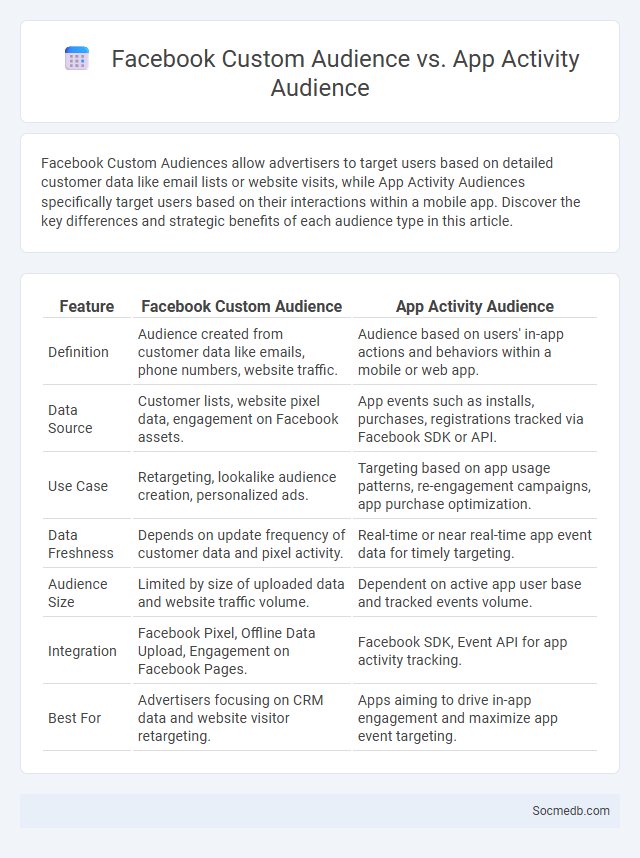
Photo illustration: Facebook Custom Audience vs App Activity Audience
Facebook Custom Audiences allow advertisers to target users based on detailed customer data like email lists or website visits, while App Activity Audiences specifically target users based on their interactions within a mobile app. Discover the key differences and strategic benefits of each audience type in this article.
Table of Comparison
| Feature | Facebook Custom Audience | App Activity Audience |
|---|---|---|
| Definition | Audience created from customer data like emails, phone numbers, website traffic. | Audience based on users' in-app actions and behaviors within a mobile or web app. |
| Data Source | Customer lists, website pixel data, engagement on Facebook assets. | App events such as installs, purchases, registrations tracked via Facebook SDK or API. |
| Use Case | Retargeting, lookalike audience creation, personalized ads. | Targeting based on app usage patterns, re-engagement campaigns, app purchase optimization. |
| Data Freshness | Depends on update frequency of customer data and pixel activity. | Real-time or near real-time app event data for timely targeting. |
| Audience Size | Limited by size of uploaded data and website traffic volume. | Dependent on active app user base and tracked events volume. |
| Integration | Facebook Pixel, Offline Data Upload, Engagement on Facebook Pages. | Facebook SDK, Event API for app activity tracking. |
| Best For | Advertisers focusing on CRM data and website visitor retargeting. | Apps aiming to drive in-app engagement and maximize app event targeting. |
Understanding Facebook Custom Audiences
Facebook Custom Audiences enable advertisers to target specific groups of users by leveraging data such as email addresses, phone numbers, or website activity. By creating these tailored audiences, businesses can deliver highly relevant ads, increasing engagement and conversion rates. This data-driven approach enhances campaign efficiency by focusing on users who have already shown interest or have interacted with the brand.
What Is App Activity Audience?
App Activity Audience refers to a group of users identified based on their interactions with your mobile app, such as installs, purchases, or in-app behaviors tracked through social media platforms. This data-driven audience allows you to target or retarget individuals who have shown interest in your app, enhancing the relevance and effectiveness of your advertising campaigns. By leveraging App Activity Audience, you can optimize your marketing strategy to boost engagement, retention, and conversions specifically within your app user base.
Defining Standard Custom Audiences
Defining standard custom audiences on social media involves segmenting users based on specific behaviors, demographics, or engagement patterns to enhance targeting precision. Your ability to create these audiences relies on data such as website visits, app activity, or customer lists integrated with platforms like Facebook Ads Manager. Leveraging these custom audiences ensures more relevant ad delivery, increasing conversion rates and optimizing ad spend efficiency.
Audience Creation: Step-by-Step Comparisons
Creating your audience on social media involves identifying target demographics, interests, and behaviors for tailored content delivery and enhanced engagement. Platforms like Facebook, Instagram, and LinkedIn offer step-by-step tools to segment users based on age, location, and activity, optimizing your campaign reach. Understanding these differences helps you effectively allocate budget and maximize return on investment through precise audience creation.
Data Sources for Each Audience Type
Social media platforms generate diverse data sources tailored to audience segments such as demographics, interests, and behaviors. For businesses targeting millennials, platforms like Instagram and TikTok provide rich engagement metrics and content interaction data. You can leverage these insights to create personalized campaigns that resonate with your specific audience's preferences and maximize conversion rates.
Targeting Precision: Which Audience Is Best?
Effective social media targeting precision relies on analyzing audience demographics, interests, and online behavior to identify the most engaged segments. Platforms like Facebook and Instagram offer advanced tools to pinpoint users based on age, location, purchase history, and interaction patterns. By leveraging data-driven insights, brands can maximize ROI by reaching highly relevant audiences most likely to convert.
Use Cases for Facebook Custom Audience
Facebook Custom Audience enables precise retargeting by uploading customer contact lists, allowing businesses to reconnect with existing clients and increase conversion rates. It supports lookalike audience creation, helping brands expand reach by targeting users similar to their best customers. Advertisers can also retarget website visitors using Facebook Pixel data to optimize ad spend and improve campaign performance.
When to Use App Activity Audience
When managing your social media strategy, use the App Activity Audience to retarget users who have engaged with your app, enhancing ad relevance and boosting conversion rates. This audience captures data based on specific in-app actions, allowing you to tailor campaigns for users most likely to respond. You can optimize your budget by focusing on those who already show interest, increasing the effectiveness of your advertising efforts.
Custom Audience Overlaps and Segmentation
Custom Audience Overlaps in social media marketing enable advertisers to identify and analyze shared users across different audience sets, enhancing targeting precision. Segmentation allows for dividing audiences based on demographics, interests, and behaviors, optimizing ad relevance and engagement. Leveraging these strategies improves campaign efficiency by reducing redundancy and increasing personalized content delivery.
Choosing the Right Audience for Your Campaign Goals
Choosing the right audience for your social media campaign is crucial to maximize engagement and return on investment. Analyzing demographic data, interests, and online behaviors ensures your message reaches users who are most likely to convert. Tailoring your content to resonate with this specific group enhances the effectiveness of Your campaign goals and drives meaningful interactions.
 socmedb.com
socmedb.com